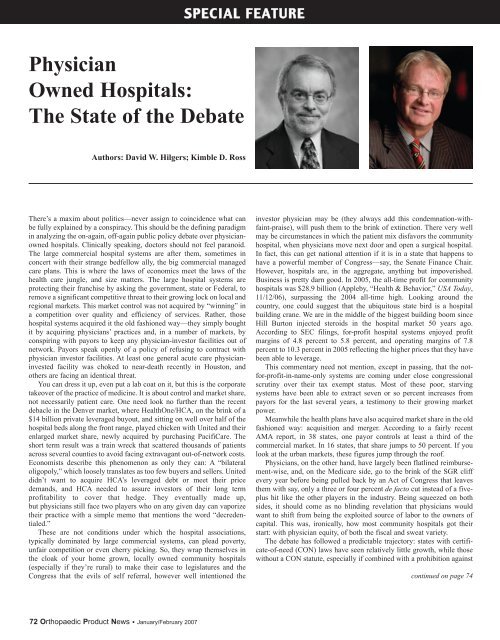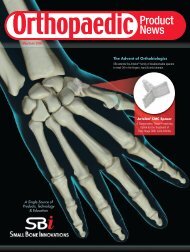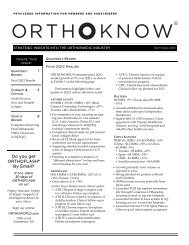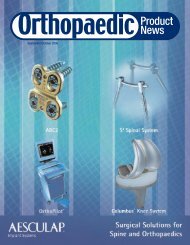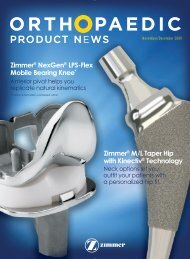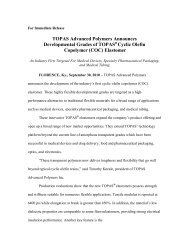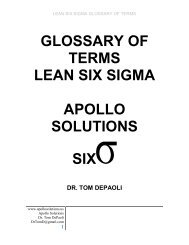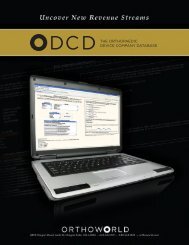AAOS, Arthroscopy - Orthoworld
AAOS, Arthroscopy - Orthoworld
AAOS, Arthroscopy - Orthoworld
You also want an ePaper? Increase the reach of your titles
YUMPU automatically turns print PDFs into web optimized ePapers that Google loves.
SPECIAL FEATUREPhysicianOwned Hospitals:The State of the DebateAuthors: David W. Hilgers; Kimble D. RossThere’s a maxim about politics—never assign to coincidence what canbe fully explained by a conspiracy. This should be the defining paradigmin analyzing the on-again, off-again public policy debate over physicianownedhospitals. Clinically speaking, doctors should not feel paranoid.The large commercial hospital systems are after them, sometimes inconcert with their strange bedfellow ally, the big commercial managedcare plans. This is where the laws of economics meet the laws of thehealth care jungle, and size matters. The large hospital systems areprotecting their franchise by asking the government, state or Federal, toremove a significant competitive threat to their growing lock on local andregional markets. This market control was not acquired by “winning” ina competition over quality and efficiency of services. Rather, thosehospital systems acquired it the old fashioned way—they simply boughtit by acquiring physicians’ practices and, in a number of markets, byconspiring with payors to keep any physician-investor facilities out ofnetwork. Payors speak openly of a policy of refusing to contract withphysician investor facilities. At least one general acute care physicianinvestedfacility was choked to near-death recently in Houston, andothers are facing an identical threat.You can dress it up, even put a lab coat on it, but this is the corporatetakeover of the practice of medicine. It is about control and market share,not necessarily patient care. One need look no further than the recentdebacle in the Denver market, where HealthOne/HCA, on the brink of a$14 billion private leveraged buyout, and sitting on well over half of thehospital beds along the front range, played chicken with United and theirenlarged market share, newly acquired by purchasing PacifiCare. Theshort term result was a train wreck that scattered thousands of patientsacross several counties to avoid facing extravagant out-of-network costs.Economists describe this phenomenon as only they can: A “bilateraloligopoly,” which loosely translates as too few buyers and sellers. Uniteddidn’t want to acquire HCA’s leveraged debt or meet their pricedemands, and HCA needed to assure investors of their long termprofitability to cover that hedge. They eventually made up,but physicians still face two players who on any given day can vaporizetheir practice with a simple memo that mentions the word “decredentialed.”These are not conditions under which the hospital associations,typically dominated by large commercial systems, can plead poverty,unfair competition or even cherry picking. So, they wrap themselves inthe cloak of your home grown, locally owned community hospitals(especially if they’re rural) to make their case to legislatures and theCongress that the evils of self referral, however well intentioned theinvestor physician may be (they always add this condemnation-withfaint-praise),will push them to the brink of extinction. There very wellmay be circumstances in which the patient mix disfavors the communityhospital, when physicians move next door and open a surgical hospital.In fact, this can get national attention if it is in a state that happens tohave a powerful member of Congress—say, the Senate Finance Chair.However, hospitals are, in the aggregate, anything but impoverished.Business is pretty darn good. In 2005, the all-time profit for communityhospitals was $28.9 billion (Appleby, “Health & Behavior,” USA Today,11/12/06), surpassing the 2004 all-time high. Looking around thecountry, one could suggest that the ubiquitous state bird is a hospitalbuilding crane. We are in the middle of the biggest building boom sinceHill Burton injected steroids in the hospital market 50 years ago.According to SEC filings, for-profit hospital systems enjoyed profitmargins of 4.8 percent to 5.8 percent, and operating margins of 7.8percent to 10.3 percent in 2005 reflecting the higher prices that they havebeen able to leverage.This commentary need not mention, except in passing, that the notfor-profit-in-name-onlysystems are coming under close congressionalscrutiny over their tax exempt status. Most of these poor, starvingsystems have been able to extract seven or so percent increases frompayors for the last several years, a testimony to their growing marketpower.Meanwhile the health plans have also acquired market share in the oldfashioned way: acquisition and merger. According to a fairly recentAMA report, in 38 states, one payor controls at least a third of thecommercial market. In 16 states, that share jumps to 50 percent. If youlook at the urban markets, these figures jump through the roof.Physicians, on the other hand, have largely been flatlined reimbursement-wise,and, on the Medicare side, go to the brink of the SGR cliffevery year before being pulled back by an Act of Congress that leavesthem with say, only a three or four percent de facto cut instead of a fiveplushit like the other players in the industry. Being squeezed on bothsides, it should come as no blinding revelation that physicians wouldwant to shift from being the exploited source of labor to the owners ofcapital. This was, ironically, how most community hospitals got theirstart: with physician equity, of both the fiscal and sweat variety.The debate has followed a predictable trajectory: states with certificate-of-need(CON) laws have seen relatively little growth, while thosewithout a CON statute, especially if combined with a prohibition againstcontinued on page 7472 Orthopaedic Product News • January/February 2007


